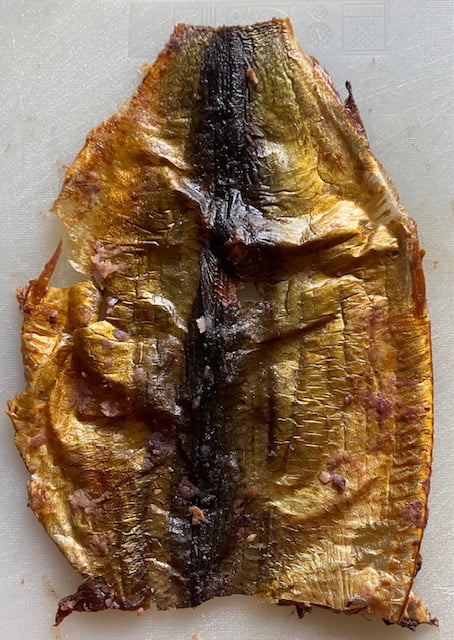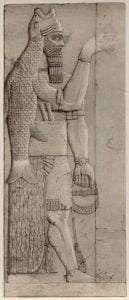On herrings and fasting, fish-based fasting on Fridays and in Lent and its origins in earlier religions, cults and/or alien contact
FASTING
Plentiful, cheap and preserved, the herring addressed the fasting needs of Europe – so much so, the fish even generated mockery and resentment.
AM Samuel, in The Herring: Its Effect on the History of Britain (1918), writes of Norwich’s festivities of 1444, when John Gladman was crowned King of Christmas and had carried in front of him both an allegorical representation of December and an effigy of Lent, that was dressed in white (salt pickled) and red (smoked) herring skins.

Samuel refers to the C16th Bavarian writer Thomas Naogeorgus and his long poem, Popish Kingdome, which was englyshed in 1570. It describes an Ash Wednesday custom in which people went about with lanterns in the middle of the day searching for the feast days that they had lost, some carrying herrings on poles and crying: Herrings, herrings, stincking herrings! Puddings are no more!
In Northern Europe, Lent became synonymous with herring. In Pieter Breughel the Elder’s The Battle Between Carnival and Lent (1559) the protagonists are armed, one with a spit of roasted meat, the other with two herrings on a paddle. Thomas Nashe’s Lenten Stuffe (1599) is a wild, anti-papist celebration of Yarmouth’s red herring. and to this very day, Catalans at Christmas, already looking forward nervously to Lent as they beat the bums of their Caga Tiós (their gift-shitting Christmas logs) sing:
Shit away, Log! / Mr Christmas Log! / Don’t go shitting herring, / Which is too salty tasting! / Shit us nougat, / Better by far!
Caga tió! / Tió de Nadal! / No caguis arengades / Que són massa salades! / Caga torrons / Que són més bons!
The fast is a means of humbling physical appetite, of cleansing the body, of focusing the spirit. Not everybody welcomes its opportunities, but it has been common to ritual observance since the earliest records of organised religion.
With fish-eating on Fridays and during Lent sanctioned, even encouraged by the Catholic Church, it became the major business opportunity, which underpinned the growth of Northern Europe’s herring fisheries.
The Case for Friday
Fridays were Christian fast days from the beginning, but in the competitive religious marketplace of the Roman Empire, one day a week was hardly going to be enough.
Thursdays and Sundays were specifically ruled out because they had been taken by the Manichaeans. Saturdays were considered, but soon abandoned except for Ember Days.
Originally pagan cleansing days with which the four seasons were greeted, the Church fixed Ember Days on the Wednesdays, Fridays and Saturdays following St. Lucia’s Day (December 13th), Ash Wednesday, Whitsunday and the Exaltation of the Cross (14th September).
The combination of Wednesdays and Fridays was fixed upon under Emperor Constantine and there is no better authority for the reasoning than St. Augustine of Hippo, writing in 396 AD:
The reason why the Church prefers to appoint the fourth and sixth days of the week for fasting, is found by considering the gospel narrative. There we find that on the fourth day of the week the Jews took counsel to put the Lord to death. One day having intervened – on the evening of which, at the close, namely, of the day which we call the fifth day of the week, the Lord ate the Passover with His disciples – He was thereafter betrayed on the night which belonged to the sixth day of the week, the day (as is everywhere known) of His passion… the Lord suffered on the sixth day of the week, as is admitted by all: wherefore the sixth day also is rightly reckoned a day for fasting, as fasting is symbolical of humiliation; whence it is said, I humbled my soul with fasting.
The primacy of Friday in the narrative of the Passion was incontrovertible. Wednesdays, like Ember Saturdays, slipped from common observance.
The Development of Lent
Weekly commemoration of the Passion may, in the early days, have been considered as an alternative to an annual event, but fasting for Lent was certainly an established practice by the early C4th.
Towards the end of the C2nd, St Irenaeus explained that, during the Holy Week, Some think they ought to fast for one day, others for two days, and others even for several, while others reckon forty hours both of day and night to their fast. The forty hours came from the time Jesus spent in the tomb; the later forty days from the time he spent in the wilderness.
By 331 AD, St. Athanasius was recommending forty days light fasting, prior to a strict fast during Holy Week itself. Eight years later, he was telling the Alexandrians that, While all the world is fasting, we who are in Egypt should not become a laughing-stock as the only people who do not fast but take our pleasure in those days.
Observance varied in the different Christian communities from eight weeks (forty days with weekends off) to three weeks light and three weeks hard, or even just a straight three weeks. In Rome it settled around thirty six days inclusive of Holy Week.
In the C7th one of the Pope Gregories added a further four to make forty. Between Ash Wednesday and Maundy Thursday there are forty four days, so someone sneaked in some more at some point.
Fish & Fasting
When Constantine was Emperor of Rome’s western provinces, he came together with Licinius, Emperor in Byzantium, to issue the Edict of Milan (313 AD) which officially tolerated Christianity throughout the empire. Licinius seems to have slid back into low-level persecution before he was defeated by Constantine in 324 AD and hanged.
At some point between the Edict of Milan and Constantine’s triumphant unification of the empire, Licinius had decreed that on certain days only salt fish could be eaten. This may have been driven by a purely economic desire to boost the fish trade.
By the fifth century, the church historian Socrates noted that among Christians, Some abstain from every sort of creature that has life, while others of all the living creatures eat of fish only. There may be a hint of Socrates’ disapproval when he writes, Others eat birds as well as fish, because, according to the Mosaic account of the Creation, they too sprang from the water.
He paints a picture of a genuinely diverse practice, including abstinence from fruit with hard shells and eggs, total abstinence and the eating of dry bread only.
The reasoning behind the dispensation on fish (and reptiles) was that they were cold-blooded and therefore not a problem when purifying the flesh.
Fish-eaters were aided by St. Paul in his first Letter to the Corinthians (Chapter XV, Verse 39): All flesh is not the same flesh: but there is one kind of flesh of men, another flesh of beasts, another of fishes and another of birds. Bird-eaters may have tried quoting Paul, too, but history denied their claims.
In Stranger Seas
There is a tendency for Church explanations not to probe the relationship between eating fish on fast days and using fish as a symbol of Christ (the Greek word for fish being Ichthus, an acrostic for Iesous Christo Theou Uiou Soter or Jesus Christ of God, the Son, the Saviour.
The symbolic, simply drawn outline of a fish was widely used by early Christian communities and has more recently been adopted by evangelicals. Born-again pagans and anthropologists point to even earlier uses, the intersecting, thin crescent moons (waxing and waning) referring both to the Goddess-Mother and her vulva.
The Chinese Great Mother Kwan-yin is represented as a fish. The Hindu Kali is the Fish-Eyed One. The Egyptian Isis is the Great Fish of the Abyss.
Moving towards the phallic, there is the intriguing origin of a bishop’s mitre in the fish head and cloak costumes of the Apkallu or Abgal, the seven demigods created by the Sumerian god Enki to bring civilization to mankind. Late in his career (around the C4th), the Semitic god Dagon took to wearing a fish head.
For theorists of the Eric von Daniken school he was unquestionably an amphibious extra-terrestrial.

Setting phallic fish heads aside, it’s possible to follow our Fish-Mother through several incarnations: Innana to the Sumerians, Ishtar to the Babylonians, Astarte to the Phoenicians (from which, of course, Easter).
As the Goddess of Love Astarte is associated with the Greek Aphrodite and the Roman Venus (from which dies veneris, Vendredi or Friday).
In Homeric culture fish eating seems to have been frowned upon, but the habit grew on the Greeks. The word delphos could denote fish or womb and was associated with the worship of the sea/fish goddess Themis at Delphi.
The later sea goddess, Aphrodite Salacia (from which salacious, in its original meaning, lustful) was celebrated on Fridays with fish eating and orgies. In their inimitable way, the early Christians may well have told her devotees that they could keep the fish if they lost the orgies. And who knows, but the Salacians might have been grateful.
In a parallel move, by placing the drawing of a fish over the swollen belly of the Virgin Mary, the early Christians acknowledged the womb, but moved the symbolic vulva away from the scene of the crime.
Alternatively, reading the Christ-fish as phallus/bishop/extra-terrestrial, they neutralised, or possibly staked their claim of ownership upon the sexuality of the otherwise independently fecund female form.
Herring Grounds
Moving into the herring’s geographical range, when the Odin-worshipping tribes of the North accepted the Roman seven day week, with a nod to dies veneris, they allocated the sixth day to Odin’s wife Freya (Friday) and celebrated her with fish eating.
Christianity thrived on the accommodation of pagan customs and in this complex of ritual possibilities it is not hard to see how fish became associated with fasting.
Writing in the eighth century, Theodulphus of Orleans regarded abstinence from fish, cheese and eggs a sign of exceptional virtue. Over the medieval period, there is no question but this tolerance gradually took on the force, almost, of an injunction. In England’s Protestant Reformation, religious fasting was abandoned, but Elizabeth I reintroduced ‘Fish Days’, mainly as an encouragement to the fishing industry. When the herring-mad Stuarts came to the English throne and did likewise, it was widely taken as a backdoor conspiracy to bring back Catholicism, denying the Englishman his God-given right to beef.
Elsewhere in Europe, via trade routes extending from Europe’s northern shores down to the Mediterranean, the Adriatic and beyond, the demand for fish (Protestant, Catholic and Orthodox) continued to be met in bulk largely with preserved herring.
See also
- AQUINAS, ST THOMAS
- BATTLE OF THE HERRINGS (1429)
- BLACK HERRING
- BRITISH FISHERY
- DIVINE PROVIDENCE
- DUMAS ON HERRING
- DUTCH GRAND FISHERY
- GOLDEN HERRING
- MARTYRED SAINT
- NASHES LENTEN STUFFE
- PROCESSION OF THE HERRINGS
- RED HERRING
- RED HERRING JOKE, THE
- SALT
- SILVER HERRING
- SOVEREIGN OF THE SEAS
- WHITE HERRING
- WILLIAMS, WILLIAM CARLOS: FISH
